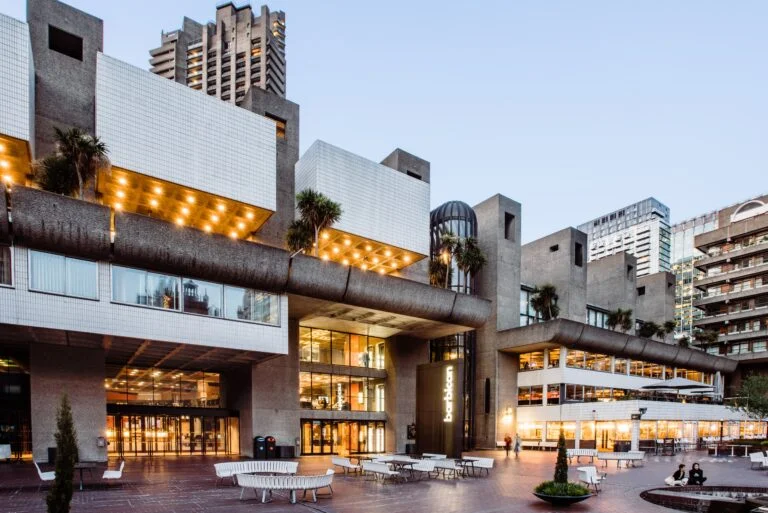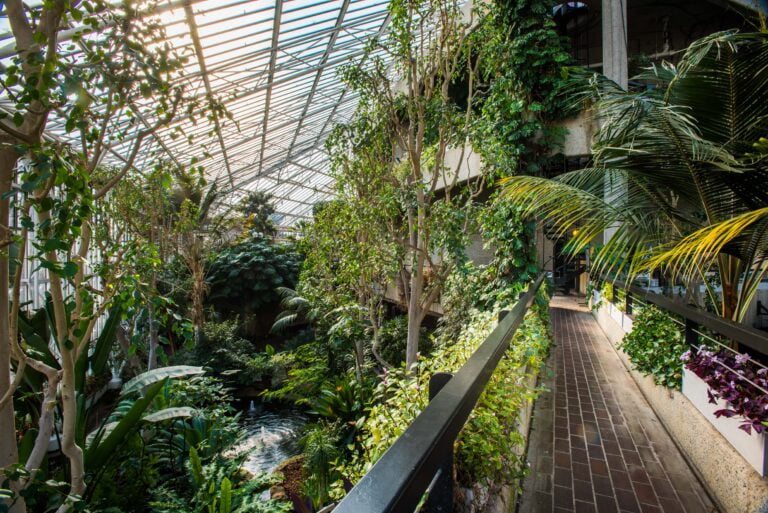The Barbican Conservatory | A glass-bound rainforest hidden within The Barbican Centre
Despite appearances, the Barbican Centre is one of most verdant patches in London.
Must be the greenhouse effect.
The Barbican is one of the city’s brutalist landmarks, famous for being ‘beautifully ugly’ (or just one of those two words, depending on who you ask). But if you’re able to look past the brutalist building’s forbidding cover of concrete – or just follow the signs and head to level three – you’ll stumble across the Barbican Conservatory, one of London’s best secret gardens.
See, while there are plenty of amazing parks in London where you can get your fill of green, they don’t have 1,500 species of tropical plants… or a roof. And given that it’s completely free to visit, it’s worth visiting the Barbican Conservatory next time you’re in the City.

Why does the Barbican Conservatory exist?
The conservatory’s placement within the Barbican Centre, a place you might normally associate more with the performing arts, isn’t a random act or an extreme example of garden negligence. The seeds were (literally) first planted in 1980 and it opened to the public four years later in 1984. It was first designed as both tourist attraction and a way to hide the fly tower from the theatre below (as that was especially unappealing for the eyes), and this side-project has since grown to become the second biggest conservatory in London (the first being the Princess of Wales in Kew Gardens). Inside, the Barbican Conservatory is home to lush greenery whose native environment spans all corners of the globe; from the bushlands of South Africa to the coastline of Brazil, some of which is now endangered in its natural habitat.
What’s in the Barbican Conservatory?

Image credit: Max Colson
The Barbican Conservatory is a very literal concrete jungle, split into two houses. In the main house, you’ll spy tree ferns, date palms, coffee and ginger plants. On the east side is the Barbican Conservatory’s Arid House, a special climate-controlled room that David Attenborough would definitely dig, filled with different species of cacti and succulents as well as an overwintering collection of cymbidiums (cool house orchids).
You’ll also pass by a number of ponds, home to koi, ghost, and grass carp from the US and Japan, as well as other cold water fish such as roach, rudd, and tench (ten points if you can tell one from the other). Plus there are a number of terrapins, who wrangled themselves a permanent home at the conservatory after antisocial behaviour amongst the other wildlife on Hampstead Heath.

Currently, all this wildlife is also making a pretty spectacular gallery for suspended sculptures by the Indian artist Ranjani Shettar. The natural forms she’s created are a striking match for the setting, and are even better enjoyed after hours at one of the conservatory’s late openings on weekends.
Finished looking at plants, now what?

Well, you are in the Barbican and since a stroll around the Barbican Conservatory normally takes around 40 minutes pending plant-watch-time, you’ve probably then got a few spare hours to take in the rest of the complex. Which you really ought to do as it’s a an iconic London attraction for a reason. You could maybe catch an exhibition in The Barbican’s art gallery; some theatre or a movie in an actual cinema (the Barbican’s cinema is included in our guide to the best cinemas in London, boasts 280-seats and shows everything from box-office blockbusters to indie festival films). It’s all here, and there’s also the chance to study up on all the exotic greenery just you’ve seen in the Barbican Library – and have a meal and a martini (there’s a dedicated martini bar, fyi) in one of the Barbican’s eight restaurants/bars.
Visiting the Barbican Conservatory

Image credit: Max Colson
And finally, the nitty-gritty. Previously, Barbican Conservatory was only open on Sundays, but given Londoners’ insatiable appetite for foliage, it’s now open almost daily – and it doesn’t cost a cent (or even a penny) to visit, making it one of the quirkier free things to do in London. But if you’re after something a little more in-depth and educational, they also offer quick 60 minute tours on Sundays, led by one of their resident gardeners, for just £12.50 a person.
It makes for a pretty wonderful thyme…
NOTE: The Barbican Conservatory is open daily. Tickets are released a week in advance on Thursdays at 10am – you can find out more, and book, here.
Barbican Conservatory | Silk Street, EC2Y 8DS
Looking for somewhere to eat afterwards? Take a look at the best restaurants in Clerkenwell
